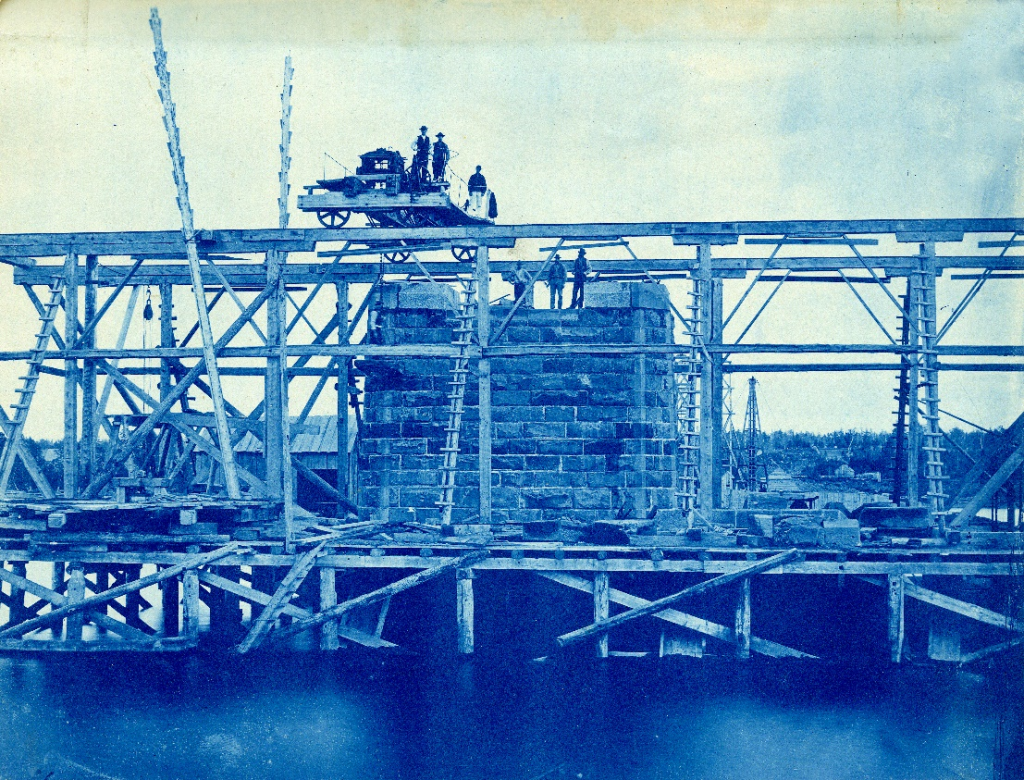
Site Location: Lat.: 46° – 6’ – 0” N; Long.: 64° – 47’ – 11” W. (GPS: 46.0832026, -64.7863692). At Moncton Via Rail Station, 77 Canada Street, Moncton, NB. From Moncton City Hall, (655 Main St.) proceed west on Main Street/Fundy Coastal Drive/NB-106 toward Downing Street. After 1.2 km, turn left (south) on Vaughan Harvey Blvd. After 0.2 km, turn left (east) on Canada St. The station is on the left.
Plaque Location: The plaque is not currently on public display.

Description: The Intercolonial Railway of Canada (railway mark: IRC), headquartered in Moncton, linked Levis, Quebec, with Saint John, New Brunswick, and Halifax, Nova Scotia. The 1,100 km (690 mi.) line officially opened on 01 July 1876 and was constructed by the International Contract Company. Sandford Fleming surveyed and laid out the route, and was Chief Engineer during construction. Numerous other IRC facilities were constructed in Moncton, including the engine house, principal workshops, freight yards, and foundry. The IRC was never a commercial success. In 1915 the IRC was integrated into the Canadian Government Railway and then, in 1923, into the Canadian National (CN) Railway. The IRC headquarters closed in 1922 but Moncton became a CN Railway regional centre. The railway shops remained in operation until 1988 when they were closed and subsequently demolished.



Historic Significance: This project was discussed extensively during the 1864 Charlottetown Conference and, at a time when few railroads existed in the Maritimes, its completion was a condition of New Brunswick and Nova Scotia joining the Dominion of Canada. The route adopted ran from Moncton to Miramichi and along the North Shore to the Matapedia Valley in Quebec because it maximised the distance from the United Sates and so would be more defensible in wartime and less accessible to Fenian raids. The Intercolonial Railway provided employment to thousands of artisans and labourers and helped develop the cities and towns along its routes, including Moncton. The Via Rail Ocean passenger train follows the entire IRC route between Halifax and Montreal except for the waterfront section in Levis. Sandford Fleming is recognized as “Canada’s foremost railway surveyor and construction engineer of the 19th century.”

Plaque Wording: National Historic Civil Engineering Site. CSCE. INTERCOLONIAL RAILWAY. Construction 1867-1876. A tribute to Canada’s Civil Engineers who created this important addition to the transportation infrastructure of Canada. Built to fulfill one of the prerequisites of Confederation, the Intercolonial Railway, which was headquartered in Moncton, linked the Maritimes with the rest of Canada since the main line ran from Lévis, Québec to Saint John, New Brunswick and Halifax, Nova Scotia. Chief Engineer Sandford Fleming. Principal Contactor: International Contract Company. Canadian Society for Civil Engineering. 2003.
Site Historique de Génie Civil. SCGC. CHEMIN DE FER INTERCOLONIAL. Construction 1867-1876. En hommage aux ingénieurs civils du Canada qui on construit cet important ajout à l’infrastructure de transport du Canada. Construit pour répondre aux conditions préalables à la confédération, le chemin de fer Interncolonial, dont le siège social était à Moncton, relait les Maritimes au reste du Canada, la ligne principale allant de Lévis, Québec, jusqu’à Halifax, Nouvelle-Écosse, en passant par Saint John, Nouveau–Brunswick. Sandford Fleming Ingénieur en chef. International Contract Company Entrepreneur. Société canadienne de genie civil. 2003.
Plaque Unveiling Ceremony: The plaque was unveiled at the Moncton Via Rail Station on June 6, 2003. N. K. Srivastava, Chair of the Moncton CSCE Conference Local Organizing Committee, was Master of Ceremonies. Dignitaries present included: Denis Beaulieu, CSCE President, who unveiled the plaque; Alistair Mackenzie, Chair of the CSCE National History Committee; Brian Murphy, Mayor of Moncton; Deputy Mayor Broderick from Riverview; and, Bill Bartlett, Regional Manager Via Rail, who received the plaque. G. Greenaugh described the historic significance of the site.
Links to Online Documentation:
“Riding the Rails”, New Brunswick Railway Museum.
J. Miller McConnell, “The New Era of the Intercolonial”, MacLean’s, 1909.
Public Services and Procurement Canada, “The Intercolonial Railway”.